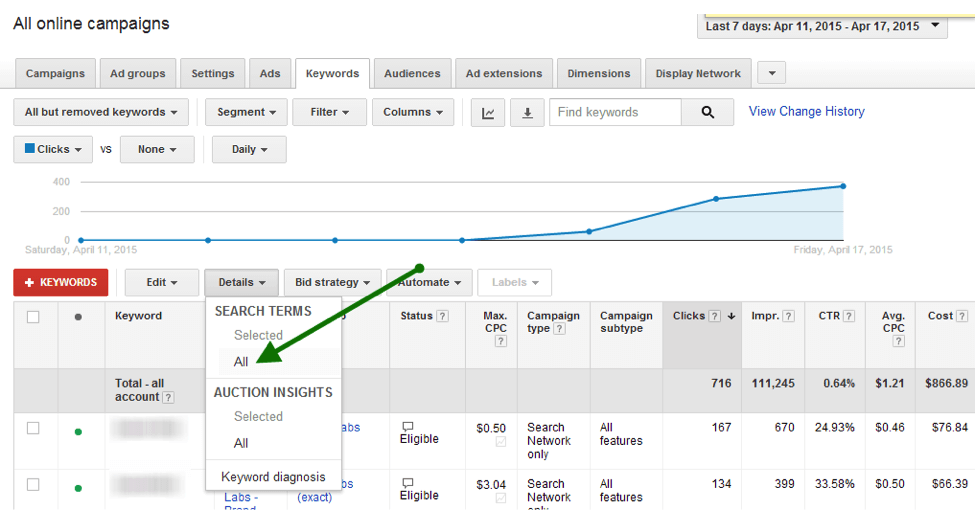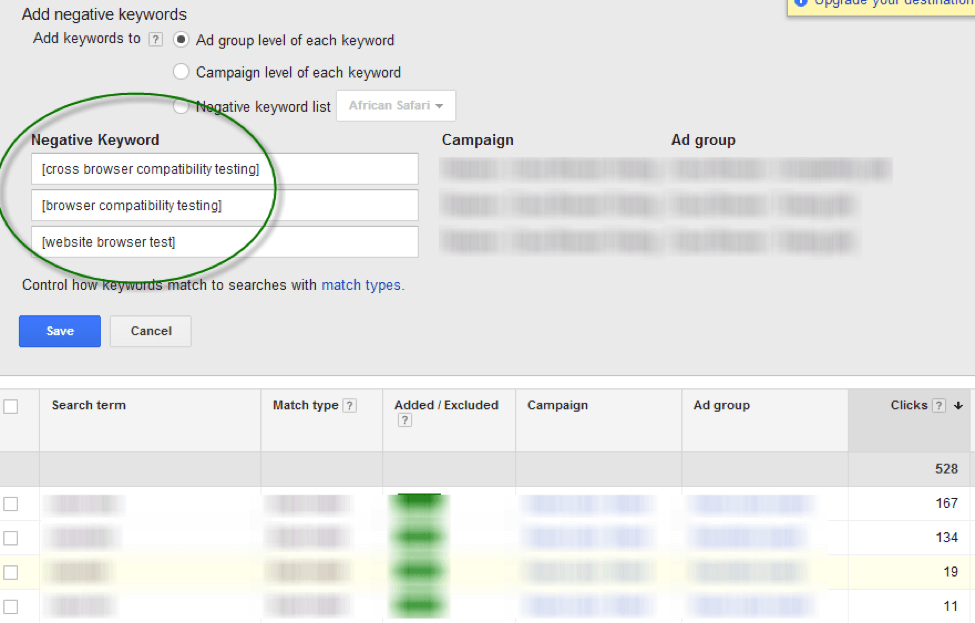Negative keywords are one of those search marketing features where there’s more to it than meets the eye. When used correctly, they can help you save budget for the best quality searches.
Let’s say you’re a housewares retailer setting up your first Google Ads campaign, and you’d like to show up on Google searches for wine or water glasses. Although a novice move, I’ve seen plenty of businesses make the common mistake of advertising for broad search queries. Here’s what often happens:
- Advertiser bids on “glasses”
- Searcher comes along and types in “glasses,” looking for a new pair of reading glasses
- Your ad featuring wine glasses shows up alongside Warby Parker’s
- Searcher accidentally clicks your ad, driving up your bill, without any intention of purchasing housewares
This is a broad example, but a dangerous one. As we’ll discover later in this post, from movie names to books to viral YouTube videos you haven’t heard of, lots of search terms that represent a product you’re selling can be more ambiguous than you think.
For starters, bolster your campaign quality with this handy list of 1,500 negative keywords every campaign should include. It’ll get your ads off the hook for things like “free” and “torrent,” which are sure to accompany or precede whatever keywords you’re bidding on in at least a handful of searches.
What Are Negative Keywords & How Do They Appear In AdWords?
Just as you type in keywords to bid on, you can also tell Google the negative keywords for which you do not want your ad to be shown. Let’s review the shorthand:
- [brackets] represent a keyword in exact match
- “quotations” represent a keyword in phrase match
- +pluses +represent a keyword in modified broad match
- no notation at all indicates standard broad match
- -minus -symbol before a keyword indicates a negative keyword
What’s The Difference Between Campaign-Level & Adgroup-Level Negatives?
Keep in mind, there are two kinds of negative keywords. You can add them at the campaign level: meaning, don’t ever show any of my ads for these keywords. And you can add them at the ad group level: meaning, don’t show my ads for negative keywords in this particular ad group.
The former is used when you know you don’t want your ads to show up for a given search; for example, if you sell tennis shoes, but there are no red shoes in your inventory and never will be, so you want to negative “red tennis shoes.”
Adgroup-level negative keywords, on the other hand, can be used to protect certain ad groups and ensure control over which chunks of the account are serving for given terms. As we’ll discuss later in this post, you might want to save your best “red tennis shoe” ads for an ad group dedicated to that product, and thus negative “red tennis shoes” (or the word “red”) in your broad match ad groups that include generic terms like +tennis +shoes.
Next, let’s explore two ways negative keywords are often used.
1. The Traditional Use
This is the most obvious use case. For example, you’re looking to capture leads where people are searching for a particular type of US work visa, and you want to ensure that the millions of searchers Googling “Visa terms & conditions” or “Visa card benefits” are not being shown your ad.
Tip: You should use Google’s search query (or keyword detail) report to identify new negative keywords, but take care to specify match type. When you use their simple selection/checkbox tool to indicate negative keywords from within the reporting screen, all negatives are automatically added in the exact match.
To fend off this “spend-more-money-with-Google” feature, simply delete the brackets around the keywords in the screenshot below for broad match, or put them in quotes for phrase match.
2. The Protective Use
In this strategy, you’re using negative keywords not because you don’t want to ever bid on the given terms, but because you want them triggered from a specific campaign.
Let’s say you’re selling men’s shoes. An example might be:
- You have a single-keyword ad group for [red puma suedes]
- You also have an ad group with broader keywords like +puma +suedes, which could potentially match a highly specific query like [red puma suedes]
- In your broader ad group, your ad copy won’t be *as specific* to the term being searched in this case
- The whole reason you have a single-keyword ad group is to serve a beautifully relevant ad for that exact search query. So, you want to “help Google help you” and make sure that is the ad group getting this impression
So you plug in [red puma suedes] as a negative keyword in your broader Puma/Suedes ad group. In fact, you negative out all the keywords in single-keyword ad groups (or in highly-targeted exact match ad groups) from your broader catch-all campaigns.
Tip: If you’re curious about single-keyword ad groups and their benefits, read up on that — built correctly, it can be a killer strategy. It may also behoove you to learn more about writing great ad copy for single-keyword ad groups.
With this “protective” use of negative keywords, you’re making sure Google doesn’t get sloppy and serve anything but the perfect ad for your searcher. This searcher knows exactly what she wants — a red Puma sneaker in suede — and by serving the perfect ad that mentions each of those adjectives, you’ve just beat all the “broad match” advertisers out there for this impression and click.
How to Build a Strong Negative Keyword List
First off, your Google and Bing reps should have lists of negative keywords they use for similar accounts. You’ll need to parse them for relevance and ensure they don’t take important terms out of play in your campaigns — but this represents a good starting point.
Next, as with planning any keyword list, you can always explore Google Keyword Planner to see related terms and understand what you might want to parse out.
You should also use Google’s search query (or keyword detail) report to identify new negative keywords. It’s by far the most effective way to see what real searches are triggering your ads and weed out the ones that don’t make sense. Here’s how you get there, starting with the Keywords tab:
Using Negative Keywords With Bing Ads
As you know, Microsoft Advertising is the platform for buying search terms on the Bing search engine. Negative keyword best practices are a bit different for this network, so let’s spend a minute on this.
One important difference between Bing and Google — which Bing’s help article on negatives subtly glosses over — is that advertisers can only designate phrase and exact match negative keywords for Bing searches.
Tip: If you import your Google campaigns into Bing like many advertisers do, be aware that your broad match negative keywords will be converted to phrase match negatives by Bing.
Bing doesn’t support keyword-level negative keywords. However, you can set up campaign and ad group level negatives, just like in Google.
Conclusion
Bidding on the best keywords in your space is only half the battle. Your success also relies upon having a sophisticated set of negative keywords that are continuously expanding and being refined based on real data. Google often does a tremendous job of sifting through millions of ads to serve the right one to a given searcher at the right time — but there is plenty of incentive for mistakes and “stretching relevance.”
The best way to ensure this doesn’t happen to you and doesn’t spend your hard-earned coin is to build negative keywords meticulously.
About the Author: Igor Belogolovsky is Co-founder of Clever Zebo, a team of conversion rate optimization experts based in the San Francisco Bay Area.



Comments (11)